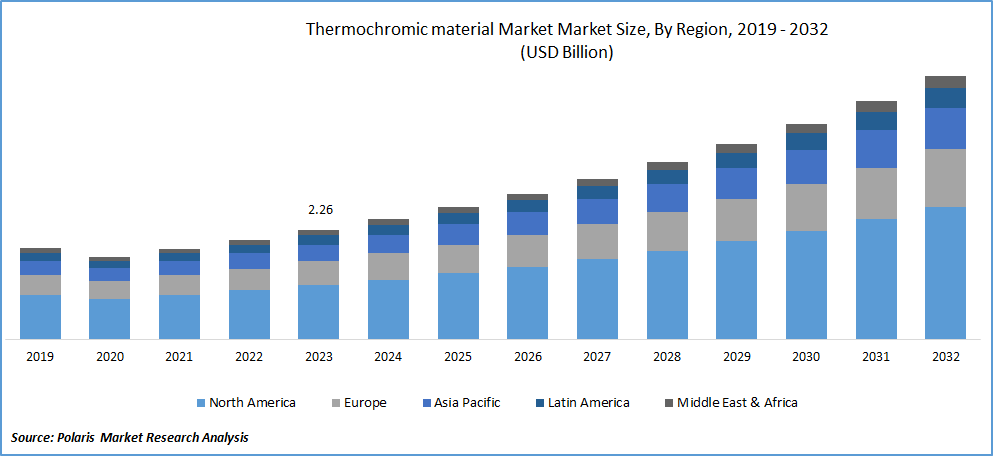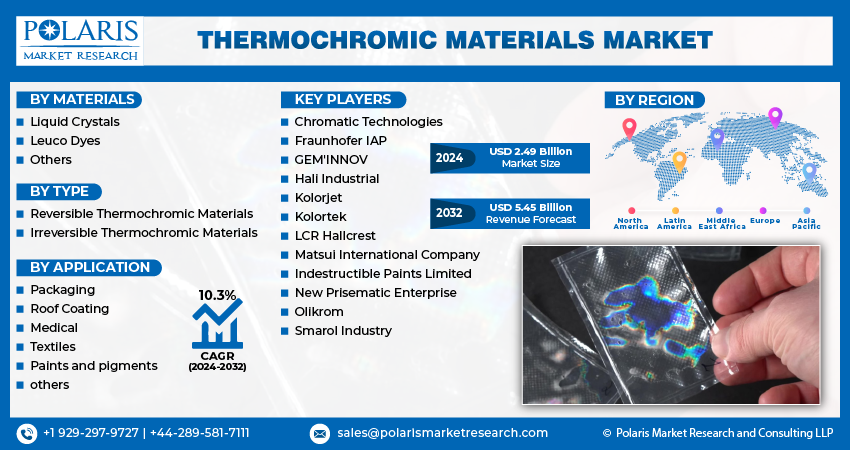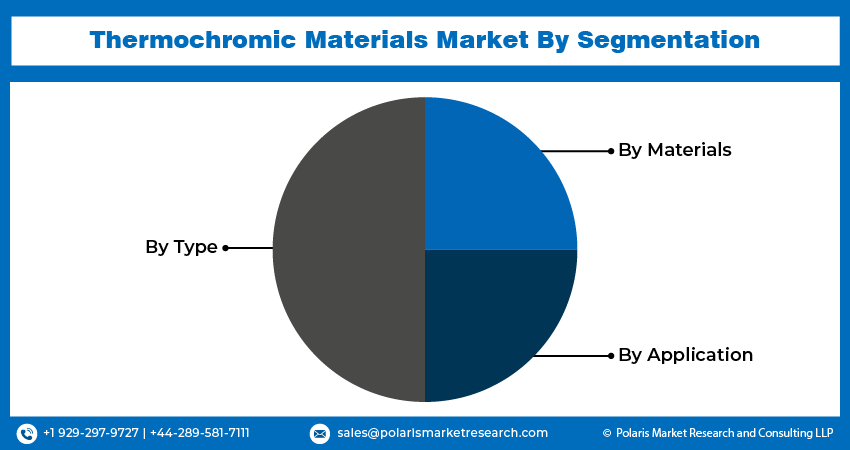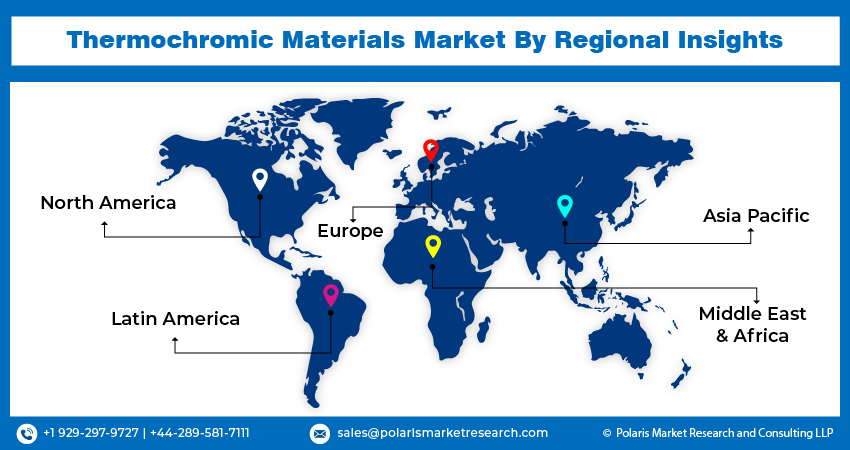
Thermochromic Material Market Share, Size, Trends, Industry Analysis Report, By Material (Liquid Crystal, Leuco Dyes, Others) By Type; By Application; By Region; Segment Forecast, 2024- 2032
- Published Date:Feb-2024
- Pages: 117
- Format: PDF
- Report ID: PM1507
- Base Year: 2023
- Historical Data: 2019-2022
Report Outlook
Thermochromic material market size was valued at USD 2.26 billion in 2023. The market is anticipated to grow from USD 2.49 billion in 2024 to USD 5.45 billion by 2032, exhibiting the CAGR of 10.3% during the forecast period.
Thermochromic material refers to a characteristic or property of certain materials that change color in response to changes in temperature. These materials are designed to undergo a reversible color change at a specific temperature range. Thermochromic materials are found in various forms, including pigments, inks, dyes, or coatings. When exposed to heat, these materials undergo a molecular or structural change that results in a visible modification of color. The color change is often reversible, meaning that when the temperature decreases, the material returns to its original color.
This property is utilized in various applications, such as mood rings, temperature-sensitive stickers, novelty items, and even in some industrial and scientific settings where monitoring temperature changes is important. The ability to visually indicate temperature variations makes thermochromic materials valuable in different fields for both practical and decorative purposes.

To Understand More About this Research: Request a Free Sample Report
One of the main reasons propelling the thermochromic materials market's expansion is the rise in demand for smart packaging applications worldwide. The industry is growing more quickly use of cutting-edge technologies like thermochromic materials to differentiate items and the widespread use of smart textiles in fashion and home furnishings applications.
Manufacturers of military hardware are becoming more conscious of the need to conceal their delicate technology from infrared detection with colors. Over the forecast years, the industry is anticipated to be supported by the application of thermochromic materials as food quality indicators to assess the quality of frozen meat and other commodities.
The market is also driven by the growing use of thermochromic materials as flexible sensors for functional applications like security or camouflage, as well as their use in energy conservation, particularly as coatings for "switchable glass" and as flexible sensors in general. The market for thermochromic materials is also positively impacted by their use in product labels, security labels, and food and beverage packaging labels, among other uses, growth in the apparel industry, and rising consumer spending power which contribute to drive the thermochromic material market growth opportunity.

Key Takeaways
- North America dominated the market and contributed to more than 40% of share in 2023
- By materials category, liquid crystals segment accounted for the largest market share in 2023
- By type category, the irreversible thermochromic materials segment is projected to grow at a high CAGR during the projected period
What are the market drivers driving the demand for thin film solar cell market?
Increase in demand for the Thermochromic Material as indicator used for food quality is driving the market growth.
The market's compound annual growth rate (CAGR) is being driven primarily by the increasing demand for thermochromic materials as indicators of food quality. The requirement for accurate labeling and marking of cooked food products has increased, due to a surge in interest in product authenticity and quality control. Food product manufacturers are searching for extremely trustworthy coding systems that would allow them to achieve their production needs for high precision and high throughput while also improving product safety.
Furthermore, in order to identify the amine levels that cause seafood to degrade, scientists have developed a food quality indicator. Thermochromic materials are used in quality testing of frozen foods, such as meat and dairy products. As a result, during the forecast period, the market under consideration would grow more quickly.
Chromatic Technologies Inc. (CTI) improves lives with chemistry that alerts, protects against, and surprises. This company fosters innovation and helps companies develop. CTI provides photochromic, thermochromic, and glow-in-the-dark ink technologies in a range of forms, colors, and temperatures to increase consumer interaction and purchase intent. By easily combining various packaging formats, such as plastic, cans, shrink, film, paper, and more, its technology provides versatility. Its adaptability makes it appropriate for a range of global supply chains and regulatory settings. Every CTI product is developed and manufactured in Colorado, USA.
Which factor is restraining the demand for thin film solar cells?
Advances in manufacturing technologies and processes.
Incorporating thermochromic materials into existing manufacturing processes can be complex. With continuous advancements in manufacturing technologies, companies may be hesitant to invest in modifying their established production lines to accommodate thermochromic materials could hinder market growth. This integration complexity could restrain the adoption of thermochromic materials in certain industries.
Also, advances in manufacturing technologies can sometimes lead to higher initial costs associated with the production of innovative materials. If the manufacturing processes for thermochromic materials become more sophisticated, it may result in increased production expenses, potentially making these materials less competitive in price compared to conventional alternatives. Continuous improvements in manufacturing technologies often necessitate ongoing research and development efforts. Manufacturers of thermochromic materials may face increased R&D costs to stay competitive and keep pace with evolving manufacturing processes, potentially affecting the overall cost-effectiveness of these materials.
Report Segmentation
The market is primarily segmented based on material, type, application and region.
|
By Materials |
By Type |
By Application |
By Region |
|
|
|
|
To Understand the Scope of this Report: Speak to Analyst
Category Wise Insights
By Materials Analysis
Based on materials analysis, the market is segmented on the basis of liquid crystals, leuco dyes, and others. In 2023, the liquid crystals segment accounted for the largest market share. The applications requiring extreme precision, such as jewelry, LCD panels, and thermometers, liquid crystals are used. Leuco dyes have a large color gamut but a narrower temperature range of accuracy. They are less costly, durable, and dye-based. Leuco dyes, which are employed in the business, and liquid crystals both abundantly exhibit the ability to change color. The easy and affordable availability of dyes globally increases the use of products on a large scale; hence, the market share of thermochromic materials has been increasing significantly.
By Type
On the basis of type, the market is segmented on the basis of reversible and irreversible thermochromic materials. These irreversible thermochromic materials segment is expected to grow at the highest CAGR during the forecast period. Irreversible thermochromic materials are substances that undergo a permanent change in color or appearance when exposed to specific temperatures.
Irreversible thermochromic materials find applications in various industries, with a focus on packaging, inks, and coating applications. These materials are integrated into packaging to provide visual indicators of temperature changes or to enhance consumer interaction with the product. In inks and coatings, irreversible thermochromic materials can be used for decorative or functional purposes.
The distinguishing feature of irreversible thermochromic materials is their ability to change in appearance when subjected to different temperatures. This property is exploited in applications such as packaging, where the material can visually indicate temperature changes or product freshness. Inks and coatings, on the other hand, can be designed to exhibit different colors or patterns based on temperature variations. Also, increased use in consumer goods, advancements in technology, and a rising awareness of the benefits of irreversible thermochromic materials in various applications drive the demand of market.

Regional Insights
North America
In 2023, North America dominated the largest market share. Interior decoration, packaging, textiles, and marketing and promotional activities are the common applications of thermodynamic materials in the region. The growing population across the globe, increased usage of frozen food and diapers, and changing aesthetic lifestyles have increased the use of thermochromic materials. This increased market share.
The United States owns a sizable share of the North American regional market due to its well-established economy, and it is predicted to grow at a relatively slower rate throughout the projected period. It is projected that the usage of these pigments in flexographic and screen-printing inks will be the primary factor driving growth in the field. Furthermore, the thermochromic material market in the US had the most market share, while the thermochromic material market in Canada was expanding at the quickest rate in the area.
Asia Pacific
The Asia-Pacific is anticipated to grow at the fastest rate during the forecast period. The rising use of thermochromic pigments in the novelty goods and textile industries, as well as the increasing demand for materials in the Japanese auto industry, are expected to propel the market expansion in this area. Rising foreign investment is also expected to quicken the pace of industry expansion in this region during the next seven years. In addition, the thermochromic material market in China had the most market share, while the thermochromic material market in India had the quickest rate of growth in the Asia-Pacific area.

Competitive Landscape
The thermochromic material market is characterized by the presence of several key players that play a significant role in shaping the industry. These players are often engaged in research and development activities, product innovation, strategic collaborations, and mergers and acquisitions to strengthen their market position. Companies in the thermochromic material market maintain diverse product portfolios to address the needs of different industries. This includes materials designed for specific temperature ranges, applications such as packaging, textiles, inks, coatings, and various color options.
- Some of the major players operating in the global market include:
- Chromatic Technologies
- Fraunhofer IAP
- GEM'INNOV
- Hali Industrial
- Indestructible Paints Limited
- Kolorjet
- Kolortek
- LCR Hallcrest
- Matsui International Company
- New Prisematic Enterprise
- Olikrom
- Smarol Industry
Recent Developments
- In November 2018, CTI introduced advanced inks designed for the creation of anti-counterfeit and tamper-proof packaging. Leveraging its BlindSpotz technology, CTI successfully addressed product tampering concerns by pioneering the first dual-indicator capable of detecting tampering through both heat and freezing conditions. This introduction of a cutting-edge tamper-proofing solution established CTI as a leading player in the manufacturing of thermochromic inks within the market.
Report Coverage
The thermochromic material market report emphasizes on key regions across the globe to provide better understanding of the product to the users. Also, the report provides market insights into recent developments, trends and analyzes the technologies that are gaining traction around the globe. Furthermore, the report covers in-depth qualitative analysis pertaining to various paradigm shifts associated with the transformation of these solutions.
The report provides detailed analysis of the market while focusing on various key aspects such as competitive analysis, material, type, application, and their futuristic growth opportunities.
Thermochromic material Market Report Scope
|
Report Attributes |
Details |
|
Market size value in 2024 |
USD 2.49 billion |
|
Revenue forecast in 2032 |
USD 5.45 billion |
|
CAGR |
10.3% from 2024 – 2032 |
|
Base year |
2023 |
|
Historical data |
2019 - 2022 |
|
Forecast period |
2024 - 2032 |
|
Quantitative units |
Revenue in USD million/billion and CAGR from 2024 to 2032 |
|
Segments Covered |
By Material, By Type, By Application, By Region |
|
Regional scope |
North America, Europe, Asia Pacific, Latin America; Middle East & Africa |
|
Customization |
Report customization as per your requirements with respect to countries, region and segmentation. |
FAQ's
The key companies in Thermochromic Material Market include Fraunhofer IAP, Hali Industrial Co. Ltd., Indestructible Paints Limited
Thermochromic material market exhibiting the CAGR of 10.3% during the forecast period.
Thermochromic Material Market report covering key segments are material, type, application and region.
The key driving factors in Thermochromic Material Market are Increase In Demand for the Thermochromic Material as Indicator Used for Food Quality is Driving the Market Growth.
Thermochromic Material Market Size Worth $ 5.45 Billion By 2032
